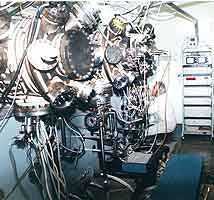
Laboratory of Physics of Magnetic Phenomena


The Laboratory of Physics of Magnetic Phenomena was founded in 1957 by Academician Leonid Kirensky. Since 1991 it has been headed by Doctor of Phys. and Math. Sciences Professor Sergey Ovchinnikov.
At present the Laboratory consists of five research teams that deal with the following scientific directions.:
- Team of Theory of Strongly Correlated Systems: electron structure and physical properties of oxides of transition metals.
- Team of Transport and Magnetic Study of Magnetic Materials: investigations of electron and magnetic phase transitions, including those at high pressure, in single crystals of oxides of transition metals.
- Team of Optical and Magnetooptical Study of Magnetic Materials: investigations of magnetic films and multilayer structures, magnetooptical glasses, magnetic materials.
- Team of nanotechnologies: development of ultrahigh-vacuum technologies of evaporation of thin magnetic films and multilayer structures.
- Team of Theoretical Simulation of Nanomaterials: ab initio calculation of atomic and electron structure of carbon and other nanoclusters and nanotubes.
The main scientific results that have been obtained at the Laboratory are listed below:
- The generalized tight binding method for calculation of band structure of cuprates and manganites has been developed; the effective Hamiltonian for cuprates accounting magnetic and electron-phonon superconductivity mechanisms has been constructed.
- The technology of Fe/Si nanostructures evaporation with in situ control of thickness and composition of layers has been developed; magnetic properties of these nanostructures have been studied.
- The complex experimental study of a system of glasses, where small additions of oxides of transition elements Fe and Mn are realized as manganese ferrite nanoparticles, has been carried out. These glasses reveal magnetically ordered properties, including the large Faraday effect, without glass transparency lost. Correlations between technological conditions, structure of ferrite nanoparticles and magnetic properties of the glasses have been found. The direct connection of magnetooptical Faraday effect value with a size and structural perfection of crystallites that form nanoparticles is observed. Recommendations for the development of magnetooptical elements on the basis of the glasses working in the spectral region 1.0…1.5 μm important for practical application have been given.
- With account for quantum effects and temperature oscillations, the maximum concentration of hydrogen that can be adsorbed on a surface of nanotubes has been calculated.
The most important results of the Laboratory activity have been presented in the following works:
- Ovchinnikov S.G., Val’kov V.V. Hubbard Operators in the Theory of Strongly Correlated Electrons. – 2004. - London-Singapore, Imperial College Press. -260c.
- Korshunov M.M., Gavrichkov V.A., Ovchinnikov S.G., Nekrasov I.A., Pchelkina Z.V., Anisimov V.I., Hybrid LDA and generalized tight-binding method for electronic structure calculations of strongly correlated electron systems // Phys.Rev. B. -2005. -72, 165104.
- Varnakov S.N., Parshin A.S., Ovchinnikov S.G., Rafaja D., Kalvoda L., Balaev A.D., Komogortsev S.V. Structural and magnetic characteristics of single-layered and multilayered Fe/Si films fabricated by thermal sputtering in ultrahigh vacuum.// Pisma v ZHTF. – 2005 – 31, issue 22, pp.1-8.
- Kliava J., Malakhovskii A., Edelman I., Potseluyko A., Petrakovskaya E., Melnikova S., Zarubina T., Petrovskii G., Bruckental Y., Yeshurun Y. Unusual magnetic transitions and nature of magnetic resonance spectra in oxide glasses containing gadolinium // Phys.Rev.B – 2005.- 71, 104406.
|